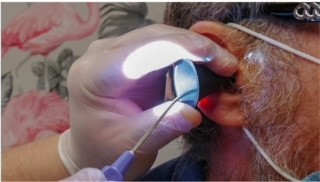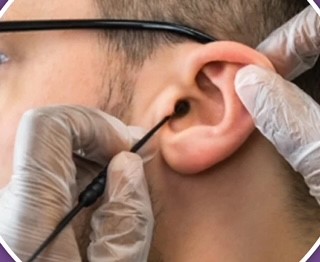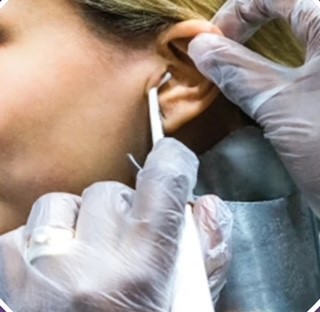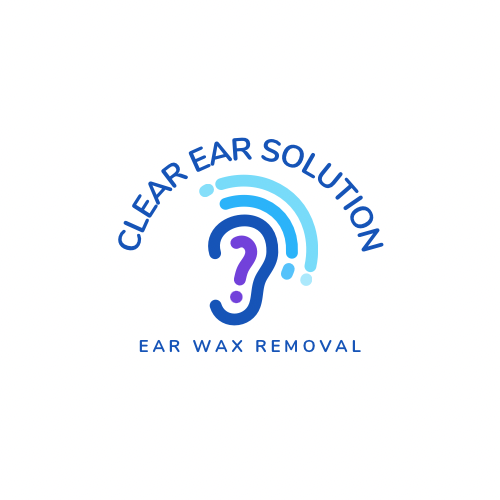Microsuction
Also known as ear vacuuming, microsuction earwax removal is the most commonly used manual technique that your doctor is likely to recommend. The procedure is relatively simple: a slender nozzle is inserted gently into the ear so that the excess wax can be siphoned out using a miniature vacuum. The entire process lasts only a few minutes (typically between 10 to 25 mins), and, once the wax is dislodged, we will remove it with either the vacuum itself, a small pair of forceps or a specialized tool known as the ‘Jobson Horne’.
Are there any side effects?
The procedure, while effective, can have mild side effects such as the following:- Minor levels of dizziness
- Discomfort in the ear canal
- An increased sensitivity to audio stimulus


Manual Ear Wax Removal
Manual earwax removal involves the use of specialized tools to remove the ear wax from the outer part of the ear canal. Sometimes it helps to physically lift the piece of ear wax if it is quite solid and deep. Often, however, manual removal will be used in conjunction with other, more advanced techniques. For instance, if one undergoes Water Irrigation, then a tool known as a ‘Jobson Horne’ may also be used in order to remove any compacted wax that the water may otherwise be unable to flush out.
When will I know there is a problem with earwax
Ear wax (or ‘cerumen’) is a naturally occurring substance that is produced by the ceruminous and sebaceous glands of the outer ear canal. It protects the ear canal by lubricating, cleaning, and fighting bacteria. In the UK, it is estimated that 2.3 million people per year have problems with ear wax.As a result, the wax gradually builds up to form a solid mass instead of being disposed of in everyday life as normal. Another common occurrence is the overuse of cotton swabs or bobby pins on the ears; much of the time, this can result in wax being pushed farther into the ear canal. This can result in serious complications.If you experience any of the following, you are advised to contact one of our specialists as soon as possible. The quicker the diagnosis, the quicker the treatment; the quicker the treatment, the quicker the recovery!- A feeling of ‘fullness’ in the ear
- Ear pain or soreness
- Hearing difficulties
- Ringing in the ears (tinnitus)
- Itchiness inside the ear
- Liquid discharge from the ear
- Noticeable odour from the ear
- Dizziness
- Vertigo
- Nausea
Water Irrigation
Ear irrigation employs a specialised electronic tool – snappily titled an ‘ear irrigator’ – which controls and maintains both the flow and temperature of the water for a precise procedure. In addition, the device aims for the wall of the ear to avoid the eardrum as much as possible.
How Should I Prepare My Ears For Water Irrigation?
We advise using olive oil drops for the three days prior to your wax removal appointment to help soften the wax. If you are desperate and able to get a same-day appointment however, oiling is not always necessary, and we may be able to remove the wax anyway. Softening the wax does increase the likelihood of total removal on the first appointment, however, if the wax cannot be removed in full a second appointment is booked at no extra charge. Over the counter drops such as Otex or Sodium Bicarbonate can offer some relief and soften the wax, however as the skin inside your ear canal is sensitive and can react very differently from person to person we do not recommend using anything other than olive oil before Water Irrigation.How Should I care For My Ears After Water Irrigation?
It is important that you should keep your ears from getting wet for 7 days after you have had Water Irrigation treatment. Place some cotton wool at the entrance of the ear canal before showering and do not submerge your head into the water. If you have had very large amounts of hard wax removed, you can experience a sore ear after the procedure – this will resolve in a few days and we would advise you not to put anything into your ear while it is settling. If you are experiencing prolonged moderate-severe pain, then you could have an underlying infection in which case we recommend you visit your GP.What If My Ears Still Feel Blocked After Water Irrigation?
There are a few reasons that your ears could still feel blocked after Water Irrigation:- Having blocked ears for weeks or months can cause a lot of pressure to build up, which will then relieve once the blockage is removed, but occasionally it can take time for this pressure to disperse.
- If you have a prolonged feeling of fullness, it may be that you have congestion behind the eardrum, in which case removing blockages from the canal will not ease the feeling of it being full. See your GP.
- Hearing loss that is related to wear-and-tear typically begins with the loss of higher frequencies of sound. This causes a muffled feeling and/or the lack of clarity in speech. It may be that even though some of your hearing has been restored after Water Irrigation has removed a blockage, you have an underlying hearing loss condition. You should speak to an audiologist to find out more about this and they can offer you a hearing test.


How safe is it?
One limitation of using operating microscopes (also known as loupes) to remove earwax is that, unlike endoscopic microsuction, the view provided is fairly narrow. As a result, patients may be required to move their heads more often in order to get the most accurate view. Overall, though, microsuction is one of the safest, most comfortable and speediest ways to remove earwax build up. Do note, however, that no method of ear wax removal is entirely risk-free. There are always certain risks, which we ensure that our patients are aware of. Some of these risks include:
- Possible damage to the eardrum in the case of error
- A temporary or permanent loss of hearing due to the occasionally loud noise in the ear – although we take extra precautions to avoid this and will remove the device immediately in the case of discomfort.
- Tinnitus (although this is rare).
- Slight dizziness – this can be as a result of the process of cooling the temperature inside the ear canal (rare and of short duration).
Who will carry out your ear wax removal?
- Qualified and HCPC registered Occupational Therapist since 2013
- Not an Audiologist but I have completed and passed my training for ear wax removal using manual removal, microsuction and water irrigation.
Contact Us
Need any more information?
Complete this form and we will get back to you as soon as we can.